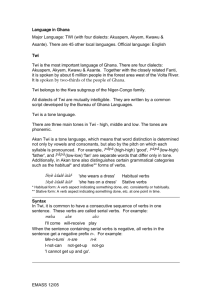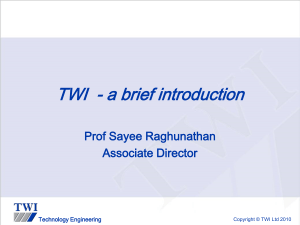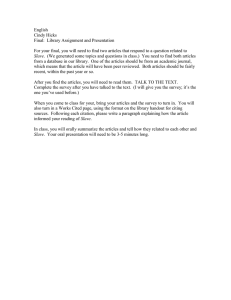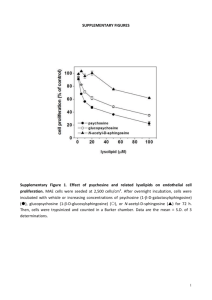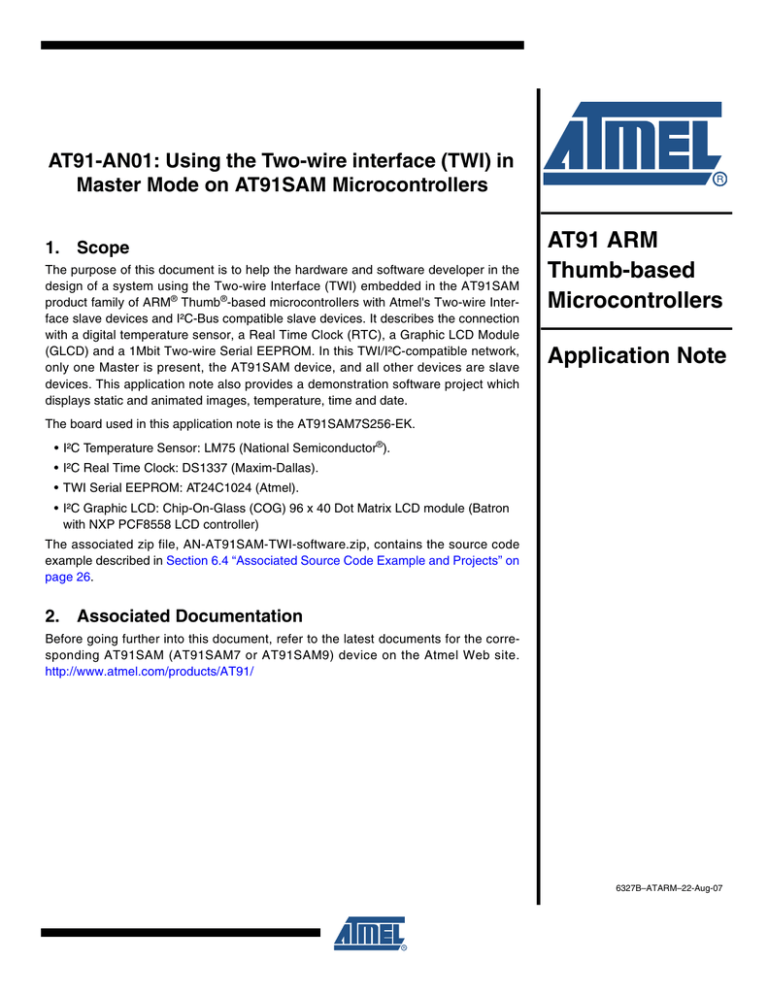
AT91-AN01: Using the Two-wire interface (TWI) in
Master Mode on AT91SAM Microcontrollers
1. Scope
The purpose of this document is to help the hardware and software developer in the
design of a system using the Two-wire Interface (TWI) embedded in the AT91SAM
product family of ARM® Thumb®-based microcontrollers with Atmel's Two-wire Interface slave devices and I²C-Bus compatible slave devices. It describes the connection
with a digital temperature sensor, a Real Time Clock (RTC), a Graphic LCD Module
(GLCD) and a 1Mbit Two-wire Serial EEPROM. In this TWI/I²C-compatible network,
only one Master is present, the AT91SAM device, and all other devices are slave
devices. This application note also provides a demonstration software project which
displays static and animated images, temperature, time and date.
AT91 ARM
Thumb-based
Microcontrollers
Application Note
The board used in this application note is the AT91SAM7S256-EK.
• I²C Temperature Sensor: LM75 (National Semiconductor®).
• I²C Real Time Clock: DS1337 (Maxim-Dallas).
• TWI Serial EEPROM: AT24C1024 (Atmel).
• I²C Graphic LCD: Chip-On-Glass (COG) 96 x 40 Dot Matrix LCD module (Batron
with NXP PCF8558 LCD controller)
The associated zip file, AN-AT91SAM-TWI-software.zip, contains the source code
example described in Section 6.4 “Associated Source Code Example and Projects” on
page 26.
2. Associated Documentation
Before going further into this document, refer to the latest documents for the corresponding AT91SAM (AT91SAM7 or AT91SAM9) device on the Atmel Web site.
http://www.atmel.com/products/AT91/
6327B–ATARM–22-Aug-07
3. Terminology, Abbreviations and Typographical Conventions
Abbreviation
Description
TWI
Two-wire Interface
A
Acknowledge
NA
Non Acknowledge
P
Stop
S
Start
Sr
Repeated Start
SADR
Slave Address
ADR
Any address except SADR
R
Read
W
Write
4. Two-wire Interface Overview
The Two-wire Interface (TWI) interconnects components on a unique two-wire bus, made up of
one clock line and one data line with speeds of up to 400 Kbits per second, based on a byte-oriented transfer format. It can be used with any Atmel Two-wire Interface bus Serial EEPROM and
I²C compatible device such as Real Time Clock (RTC), Dot Matrix/Graphic LCD Controllers and
Temperature Sensor, to name but a few. The TWI is programmable as master transmitter or
master receiver with sequential or single-byte access. A configurable baud rate generator permits the output data rate to be adapted to a wide range of core clock frequencies. Below, Table
4-1 lists the compatibility level of the Atmel Two-wire Interface and a full I²C compatible device.
Table 4-1.
Atmel TWI Compatibility with I²C Standard
I²C Standard
Atmel TWI
Standard Mode Speed (100 KHz)
Supported
Fast Mode Speed (400 KHz)
Supported
7 or 10 bits Slave Addressing
Supported
(1)
START BYTE
Not Supported
Repeated Start (Sr) Condition
Not Fully Supported(2)
ACK and NACK Management
Supported
Slope control and input filtering (Fast mode)
Not Supported
Clock stretching
Supported
Notes:
1. START + b000000001 + Ack + Sr
2. A repeated start condition is only supported in Master Receiver mode.
2
Application Note
6327B–ATARM–22-Aug-07
Application Note
5. Hardware Considerations
As shown in Figure 5-1, the Two-wire/I²C Network is made of one Master device, the AT91SAM,
and several slave devices. The communication is always between the master and one slave at a
time.
Figure 5-1.
Application Block Diagram
VDD
Rp
AT91SAM
(Master)
Rp
TWD
TWCK
Atmel TWI
Serial EEPROM
Slave 1
I²C RTC
I²C LCD
Controller
I²C Temp.
Sensor
Slave 2
Slave 3
Slave 4
Rp: Pull up value as given by the I²C Standard
5.1
Bus Capacitance, Pull-up and Rise Time
Due to the architecture of the bus shown below and the bi-directional communication on the data
line, the master and the slave devices connected to the bus must have open drain (or open collector) Input/Output buffers. A pull-up resistor on TWD and TWCK is thus needed to drive the
clock and data line low. The value of the pull-up resistors is driven by the total capacitance of the
bus (input capacitance of each slaves, wire, connectors, PCB layout) and the TWI bit rate. The
number of slave devices that can be connected to the bus is limited only by the maximum bus
capacitive loading of 400 pF. Figure 5-2 below, shows the Input/output buffers with two slave
devices connected to the bus. Since the transition time from low level to high level (rise time) is
determined by the RC network formed by Rp resistors and bus capacitance, the Rp value has to
be computed to match the rise time required by the I²C Standard, see Table 5-2.
Table 5-1.
I/O Lines Description
Pin Name
Pin Description
TWD
Two-wire Serial Data
Open Drain
Input/Output
TWCK
Two-wire Serial Clock
Open Drain
Output
Table 5-2.
Type
TWI/I²C bit rate versus rise time
Bit rate
Rise time (see Figure 5-3)
Standard Mode (100 KHz)
1 µs Max.
Fast Mode (400 KHz)
300 ns Max.
3
6327B–ATARM–22-Aug-07
Figure 5-2.
Input/Output Buffers
+VDD
Rp
Rp
TWD (Data)
TWCK (Clock)
TWD
OUT
TWD
OUT
TWCK
IN
TWD
IN
Slave 1
Figure 5-3.
TWCK
IN
TWD
IN
Slave 2
Rise Time
V
Rise time
(Tr)
VDD
VIH
0.7xVDD
VIL
VOL
0.3xVDD
0.4V / Isink = 3 mA
GND
t
The rise time (Tr) defined between 30% and 70% of VDD is equal to:
Vdd – Vih
Tr = – τx ln ⎛ --------------------------⎞ = 0, 847 τ
⎝ Vdd – Vil ⎠
where:
Tr: rise time
τ: Rp x Cbus (Bus Capacitance)
Tr = 0.847 x Rp x Cbus
Figure 5-4 and Figure 5-5 below (from the I²C-bus specification), show the Rp pull-up resistor
range for both the standard mode and fast mode bit rate.
4
Application Note
6327B–ATARM–22-Aug-07
Application Note
5.2
Figure 5-4.
Maximum value of Rp as a function of bus Capacitance for Fast-mode
Figure 5-5.
Maximum value of Rp as a function of bus Capacitance for Standard-mode
Mixing 5V and 3.3V Devices
The I²C-bus specification originally focussed on 5V devices. Since the I²C-Bus Specification 2.0,
3.3v devices have been taken into account. Most of the newest TWI/I²C devices (Master or
Slave) have their Input/Output buffers powered at 3.3v. Some devices are still using 5V digital
logic. Some AT91SAM devices have 5V-tolerant I/Os. This allows combine slave devices operating at 5V and 3.3V on the same bus without using level shifters. Check the corresponding
product datasheet of the AT91SAM device. If the AT91SAM device is not 5V tolerant, level
shifters must be used.
5.3
Mixing Standard-mode and Fast-mode Devices
Standard-mode (100 kHz) and Fast-mode (400 kHz) devices can be connected on the same
bus. But the Fast-mode devices will be clocked at 100 kHz for proper operations. Since the slave
address is sent to all devices on the bus, sending a slave address at 400 kHz to 100 kHz
devices will not be safe. To work around this, one can use an I²C-bus repeater, such as the NXP
PCA9515 or the equivalent, to split the TWI/I²C bus into two buses; Standard Mode bus and Fast
Mode bus.
5.4
Communication with Long Cables
A designer might need to build a TWI/I²C network between different boards separated by several
meters. (Such as a motherboard of a vending machine or industrial control machine where small
LED or Graphic Display and/or keypad that are separated from the main unit and communicating
5
6327B–ATARM–22-Aug-07
with the main unit via I²C.) Due to the 400 pF bus capacitance limit, using long cables (80 pF/m)
rapidly decreases the number of slave devices that can be connected to the bus. To work
around this limitation, a bus extender can be used such as the NXP PCA951x, P82B715,
P82B96, or the equivalent. Possible distances range from 50 meters at 85 kHz to 1 kilometer at
31 kHz over twisted-pair phone cables. Up to 400 kHz over short distances.
5.5
TWI Network Board Schematic
The schematic given below shows the hardware connection of the slave devices listed in Section 1.
Figure 5-6.
TWI Network Board Schematic
VDD
-3.5v to -2.5v
Supply Voltage for
LCD (Contrast
adjustment)
100nF
1
2
JUMPER JP1
3
4
NC
VCC
8
7
A1
WP
NC
SCL
GND
SDA
100nF
6
5
3
AT24C1024 Atmel EEPROM
4
5
1
2
Rp1
6.8K
VDD
SCL
SDA
SQW
GND
Rp2
6.8K
40
VLCD
VDD
SCL
96 x 40 DOTS
PHILIPS
PCF8558
SDA
96
GND
BATRON - Chip-onglass LCD Module
SCL
SDA
SQW
VDD
100nF
VDD
1
32,768kHz watch crystal
X1
VCC
2
X2
SQW/OUT
3
INTA
SCL
GND
SDA
4
8
Rp
2.2K
7
SQW
6
2
5
1
3
DS1337 Maxim- Dallas
RTC
VDD
100nF
4
8
SCL
+VS
SDA
A0
O.S
A1
6
A2
5
GND
JUMPER JP3
7
JUMPER JP4
JUMPER JP5
LM75 Digital Temp. Sensor
5.5.1
Pull-up and Bus Capacitance Computation
The input capacitances given in the table below are the maximum input capacitances per line,
i.e. for TWCK (SCL) and TWD (SDA)
Table 5-3.
6
Input Capacitance
Slave Device
Max. Input Capacitance (Cin)
Maxim-Dallas DS1337 RTC
10 pF
NS LM75 Temperature Sensor
20 pF
GLCD Batron (NXP PCF8558)
7 pF
Atmel AT24C1024
8 pF
PCB, Wires, Connectors
5 pF
Total (Cbus):
50 pF
Application Note
6327B–ATARM–22-Aug-07
Application Note
As seen in Figure 5-3 on page 4, the rise time, Tr, is equal to 0,847 x Rp x Cbus. For a 400 kHz
data rate, Rp equals 7.1K ohms whereas the closest standard value for 5% resistor is 6.8K
ohms. All the slave devices used in this application are able to run at this frequency.
5.5.2
Resetting a TWI/I²C Slave Device
The TWI/I²C slave devices used in this application note do not have a hardware reset input pin.
Most of the other slave devices on the market do not have a reset input. In case of a general
system reset, failure or the master is interrupted by a higher priority task while transmitting a
TWI/I²C frame, the master will end the transfer. The slave device may not finish the transfer due
to the fact that the master has stopped the communication. It may happen that the slave holds
the TWD/SDA line low and waits for the next clock pulse from the master. In this situation, when
the master will resume the TWI/I²C transfer, the master will not be able to start the communication again due to the low state on the data line, which means that the bus is hung up.
Nevertheless, solutions exist to recover the communication between master and slave. The first
one is purely a software work around. The master must send from one to nine clock pulses at a
maximum and monitor the TWD/SDA line to check if the line goes high. If the line goes high, a
stop condition must be sent by the master. Since the TWI peripheral cannot resume when its
TWD line is kept low, the user will have to reprogram the TWD and TWCK pins into PIO mode to
perform the recovery procedure. The procedure described above, called “bus recovery procedure”, is detailed below.
The bus recovery procedure is as follows:
1. Master tries to assert a Logic 1 on the SDA line
2. Master still sees a Logic 0 and then generates a clock pulse on SCL (1-0-1 transition)
3. Master examines SDA. If SDA = 0, go to Step 2; if SDA = 1, go to Step 4
4. Generate a STOP condition
This procedure is a generic one. Check your slave device datasheet as another bus recovery
procedure may be available.
Another way to reset a slave device, is to drive the VDD and/or GND pin of a slave device via the
main system reset signal driven by a transistor and with a PIO pin of the AT91SAM device to
perform a warm reset. A schematic example is shown below for a serial EEPROM.
2
PIO
VDDIO
100K
BAT 54A
1
3
Si1563EDH
100K
NRST
4
3
5
2
6
1
1K5
1K5
AT24C1024
1
2
3
7
NC
A1
NC
WP
SCL
SDA
6
5
VCC
8
GND
4
TWCK
TWD
100NF
7
6327B–ATARM–22-Aug-07
6. Software and Application Considerations
The Transfer Format and Modes of Operation sections below give a brief reminder of the TWI
operation. For further details and register definitions refer to the corresponding AT91SAM7 or
AT91SAM9 datasheet.
6.1
Transfer Format
The data put on the TWD line must be 8 bits long. Data is transferred MSB first; each byte must
be followed by an acknowledgement. The number of bytes per transfer is unlimited (see Figure
6-1).
Figure 6-1.
Transfer Format
TWD
TWCK
Start
Address R/W
Ack
Data
Ack
Data
Ack
Stop
Each transfer begins with a START condition and terminates with a STOP condition (see Figure
6-2).
• A high-to-low transition on the TWD line while TWCK is high defines the START condition.
• A low-to-high transition on the TWD line while TWCK is high defines a STOP condition.
Figure 6-2.
START and STOP Conditions
TWD
TWCK
Start
6.2
Stop
Modes of Operation
The TWI has two modes of operation:
• Master Transmitter Mode: Master Writes Data into the Slave
• Master Receiver Mode: Master Reads Data from the Slave
For both modes, the TWI is able to perform single or multiple (sequential) read/write operations.
Depending on the slave device, single read or write accesses will be used. This is the case for
the LM75 temperature sensor where most of the time, only the temperature register will be read.
For slave devices such as the graphic LCD and the serial EEPROM, sequential read and write
accesses will be done. The RTC used in this application note, is also accessed sequentially to
read the second, minute, hour, day registers and so on. Each of the devices having sequential
accesses for their registers or memory locations, can of course be accessed in single access
mode, but this will increase the overall access time. This is particularly true when accessing a
memory page in the serial EEPROM.
8
Application Note
6327B–ATARM–22-Aug-07
Application Note
6.2.1
Internal Address
When addressing slave devices, the internal address bytes are used to perform random address
(read or write) accesses to reach one or more data bytes from an offset location, within a memory page location in a serial memory, for example. When performing read operations with an
internal address, the TWI performs a write operation to set the internal address in the slave
device, and then switch to Master Receiver mode. Note that the second start condition (after
sending the IADR) is sometimes called “repeated start” (Sr) in I²C fully-compatible devices. See
Figure 6-3 and Figure 6-4 below.
Figure 6-3.
Single Data Byte Write with Internal Address
One byte internal address
TWD
Figure 6-4.
S
DADR
W
A
IADR(7:0)
A
DATA
A
P
Single Data Byte Read with Internal Address
One byte internal address
TWD
6.2.1.1
S
DADR
W
A
IADR(7:0)
A
Sr
DADR
R
A
DATA
N
P
TWI Operations
To summarize, the TWI can perform the following operations.
• Master Transmitter Mode (Master writes to the Slave)
– Single Data byte Write
– Single Data byte Write with Internal Address (Slave register offset)
– Multiple Data byte Write
– Multiple Data byte Write with Internal Address (Slave register offset)
• Master Receiver Mode (Master reads from the Slave)
– -Single Data byte Read
– Single Data byte Read with Internal Address (Slave register offset)
– Multiple Data byte Read
– Multiple Data byte Read with Internal Address (Slave register offset)
6.3
6.3.1
Slave devices
National LM75 Digital Temperature Sensor
The LM75 is a temperature sensor with an accuracy of ±2° C(max) for -25° C to 100° C temperature range, and ±3° C(max) for -55° C to 125° C range. It has an open-drain Over-temperature
output which will be active when the temperature exceeds a programmable limit configured via
the Temperature Output Shutdown (TOS) Register. This is not used in this application note. The
LM75 has four internal (hardwired) slave address bits and three external (user defined) slave
address bits. Up to eight sensors can be connected on the bus.
Slave address format: 1-0-0-1 + A2-A1-A0 (A2 to A0 are user defined bits).
In this application note, the following address is used: “1-0-0-1” + A0=A1=A2= +VDD = 0x4F.
The LM75 has four data registers selectable by a 5th register, the pointer register. This means
that each time one of the four data registers need to be read or written, the pointer register must
be set beforehand.
9
6327B–ATARM–22-Aug-07
• Pointer Register: 8-bit (only 2 LSB’s are significant)
• Configuration Register: 8-bit
• Temperature Register: 16-bit (only 9 MSBs are significant)
• Temperature Output Shutdown Register: 16-bit (only 9 MSBs are significant)
• Temperature Hysteresis Register: 16-bit (only 9 MSBs are significant)
6.3.1.1
8-bit Register Access
To access the 8-bit registers, a single byte read or write access is needed if the pointer register
is already set to the correct register to access. Figure 6-5 shows the transfer format when reading from the configuration register when the pointer has already been set.
Figure 6-5.
1-byte Configuration Register Read with Pointer Register Pre-set
The TWI must be programmed as shown in Figure 6-6 on page 11.
10
Application Note
6327B–ATARM–22-Aug-07
Application Note
Figure 6-6.
Single Data Byte Read
BEGIN
Set TWI clock
(CLDIV, CHDIV, CKDIV) in TWI_CWGR
(Needed only once)
Set the Control register:
- Master enable
TWI_CR = MSEN
Set the Master Mode register:
- Device slave address
- Transfer direction bit
Read ==> bit MREAD = 1
Start the transfer
TWI_CR = START | STOP
Read Status register
RXRDY = 1?
No
Yes
Read Receive Holding register
Read Status register
No
TXCOMP = 1?
Yes
END
If the pointer register is not pre-set to the correct register to access, an extra “Pointer Byte” must
be sent before writing to or reading from the register during the same access. Figure 6-7 shows
the transfer format when reading from the Configuration register when the pointer has not
already been set. This can be done by using the Internal Address register (TWI_IADR) of the
TWI. The value of the Pointer Register will be the value in TWI_IADR.
11
6327B–ATARM–22-Aug-07
Figure 6-7.
1-byte Configuration Register Read with Pointer Byte Not Pre-set
In this case, the TWI must perform a single data byte read with use of the internal address register (TWI_IADR). The TWI will have to be programmed as shown in Figure 6-8 on page 13 for
reading and Figure 6-9 on page 14 for writing.
12
Application Note
6327B–ATARM–22-Aug-07
Application Note
Figure 6-8.
Single Data Byte Read with Internal Address
BEGIN
Set TWI clock
(CLDIV, CHDIV, CKDIV) in TWI_CWGR
(Needed only once)
Set the Control register:
- Master enable
TWI_CR = MSEN
Set the Master Mode register:
- Device slave address
- Internal address size (IADRSZ)
- Transfer direction bit
Read ==> bit MREAD = 1
Set the internal address
TWI_IADR = address
Start the transfer
TWI_CR = START | STOP
Read Status register
No
RXRDY = 1?
Yes
Read Receive Holding register
Read Status register
No
TXCOMP = 1?
Yes
END
13
6327B–ATARM–22-Aug-07
Figure 6-9.
Single Data Byte Write with Internal Address
BEGIN
Set TWI clock
(CLDIV, CHDIV, CKDIV) in TWI_CWGR
(Needed only once)
Set the Control register:
- Master enable
TWI_CR = MSEN
Set the Master Mode register:
- Device slave address (DADR)
- Internal address size (IADRSZ)
- Transfer direction bit
Write ==> bit MREAD = 0
Set the internal address
TWI_IADR = address
Load Transmit register
TWI_THR = Data to send
Read Status register
No
TXRDY = 1?
Yes
Read Status register
TXCOMP = 1?
No
Yes
Transfer finished
14
Application Note
6327B–ATARM–22-Aug-07
Application Note
6.3.1.2
16-bit Register Access
To access the 16-bit registers, a multiple byte read or write access is needed if the pointer register is already set to the correct register to access. Figure 6-10 shows the transfer format when
reading from the temperature register (16-bit) when the pointer has already been set.
Figure 6-10.
2-byte Temperature Register Read with Pointer Register Pre-set
In this case, the TWI must be programmed as shown in Figure 6-11 on page 16.
15
6327B–ATARM–22-Aug-07
Figure 6-11. Multiple Data Byte Read
BEGIN
Set TWI clock
(CLDIV, CHDIV, CKDIV) in TWI_CWGR
(Needed only once)
Set the Control register:
- Master enable
TWI_CR = MSEN
Set the Master Mode register:
- Device slave address
- Transfer direction bit
Read ==> bit MREAD = 1
Start the transfer
TWI_CR = START
Read Status register
RXRDY = 1?
No
Yes
Read Receive Holding register (TWI_RHR)
No
Next-to-last data received?
Yes
Stop the transfer
TWI_CR = STOP
Read Status register
No
RXRDY = 1?
Yes
Read Receive Holding register (TWI_RHR)
Read status register
TXCOMP = 1?
No
Yes
END
As in 8-bit register accesses, if the pointer register is not already set to the correct register to
access, the “Pointer Byte” of the LM75 must be sent before writing to or reading from the register
during the same access. Figure 6-12 shows the transfer format when reading from the hysteresis or output shutdown temperature register when the pointer has not already been set. This can
be done by using the Internal Address register (TWI_IADR) of the TWI. The value of the Pointer
Register will be the value in TWI_IADR.
16
Application Note
6327B–ATARM–22-Aug-07
Application Note
Figure 6-12. 2-byte Temperature Hysteresis/Tos Register Read with Pointer Register not Pre-set
In this case, the TWI must be programmed as shown in Figure 6-13 for reading and Figure 6-14
on page 19 for writing.
17
6327B–ATARM–22-Aug-07
Figure 6-13. Multiple Data Byte Read with Internal Address
BEGIN
Set TWI clock
(CLDIV, CHDIV, CKDIV) in TWI_CWGR
(Needed only once)
Set the Control register:
- Master enable
TWI_CR = MSEN
Set the Master Mode register:
- Device slave address
- Internal address size
- Transfer direction bit
Read ==> bit MREAD = 1
Set the internal address
TWI_IADR = address
Start the transfer
TWI_CR = START
Read Status register
RXRDY = 1?
No
Yes
Read Receive Holding register (TWI_RHR)
No
Next-to-last data received?
Yes
Stop the transfer
TWI_CR = STOP
Read Status register
No
RXRDY = 1?
Yes
Read Receive Holding register (TWI_RHR)
Read status register
TXCOMP = 1?
No
Yes
END
18
Application Note
6327B–ATARM–22-Aug-07
Application Note
Figure 6-14. Multiple Data Byte Write with Internal Address
BEGIN
Set TWI clock
(CLDIV, CHDIV, CKDIV) in TWI_CWGR
(Needed only once)
Set the Control register:
- Master enable
TWI_CR = MSEN
Set the Master Mode register:
- Device slave address
- Internal address size
- Transfer direction bit
Write ==> bit MREAD = 0
Set the internal address
TWI_IADR = address
Load Transmit register
TWI_THR = Data to send
Read Status register
TWI_THR = data to send
No
TXRDY = 1?
Yes
Data to send?
Yes
Read Status register
Yes
No
TXCOMP = 1?
END
6.3.1.3
Source Code Example
The following C functions are provided with this application note. (File: lm75.c and lm75.h)
AT91F_LM75_ReadConfigurationRegister
AT91F_LM75_SetConfigurationRegister
AT91F_LM75_ReadThystRegister
AT91F_LM75_SetThysRegister
AT91F_LM75_ReadTosRegister
AT91F_LM75_SetTosRegister
AT91F_LM75_ReadTempRegister
How to use these functions is shown in source code GLCD-TempSensor.c and in All-in-oneDemo.c
19
6327B–ATARM–22-Aug-07
6.3.2
6.3.2.1
Maxim-Dallas DS1337 Real Time Clock
The DS1337 Real-Time Clock (RTC) provides clock and calendar information with seconds,
minutes, hours, day, date, month, and year information. It also features two time-of-the day
alarms. The DS1337 has an open-drain, programmable Square-Wave Output signal (SQW).
This signal is used in this TWI Network Demo as 1Hz tick time for reading clock and calendar
information each seconds. The clock operates in either the 24-hour or 12-hour format with
AM/PM indicator. The DS1337 has sixteen registers. The first seven are for second, minute,
hour, day, date, month, and year information and the remaining registers for alarm settings, control and status. Each register is 8 bits wide. Before accessing one of the registers, the register
pointer (noted as “Word Address” in the figures below) must be set to the right register offset, i.e.
seconds or minutes or day, etc. The DS1337’s slave address is b110 1000 (0x68).
Data Write - Slave Receiver Mode
This mode is used when writing one or several registers. A word address (pointer register offset)
must be sent before sending the value to write in the corresponding register(s). Each time a register is written, the pointer register offset is automatically incremented.
Figure 6-15. Data Write - Slave Receiver Mode
To write one or more registers, the TWI must be used in single or multiple data byte write operation with one byte internal address as shown in Figure 6-9 on page 14 for single data and Figure
6-14 on page 19 for multiple data.
6.3.2.2
Data Read - (from Current Pointer Location) - Slave Transmitter Mode
This mode is the same as Data Write mode, but with no word address to program in the
DS1337. If only one register needs to be read, the TWI must be programmed as shown in Figure
6-6 on page 11. If Several registers must be read during the same access, the TWI must be programmed as shown in Figure 6-11 on page 16.
Figure 6-16. Data read - (from Current Pointer Location) - Slave Transmitter Mode
6.3.2.3
20
Data Read (Write Pointer, then Read) - Slave Receive and Transmit
In this mode, the Word Address (Pointer) is not pre-set to point to the register to be accessed. A
write into the pointer register must be done before reading. For this, performing a read access
(Single or Multiple Data Byte) with internal address set, the TWI will first execute a write access,
to set the pointer register and then will start reading from the slave. In the Figure 6-17 below, the
Application Note
6327B–ATARM–22-Aug-07
Application Note
Sr (repeated start) is automatically handled by the TWI. To program the TWI in Single or Multiple
data byte read with internal address, refer to Figure 6-8 on page 13 and Figure 6-13 on page 18.
Figure 6-17. Data Read (Write Pointer, then Read) - Slave Receive and Transmit
6.3.2.4
Source Code Example
The following C functions are provided with this application note. (File: ds1337.c and ds1337.h)
AT91F_DS1337_SetSeconds
AT91F_DS1337_ReadSeconds
AT91F_DS1337_SetMinutes
AT91F_DS1337_ReadMinutes
AT91F_DS1337_SetHours
AT91F_DS1337_ReadHours
AT91F_DS1337_SetDay
AT91F_DS1337_ReadDay
AT91F_DS1337_SetDate
AT91F_DS1337_ReadDate
AT91F_DS1337_SetMonth
AT91F_DS1337_ReadMonth
AT91F_DS1337_SetYear
AT91F_DS1337_ReadYear
AT91F_DS1337_SetDateTime
AT91F_DS1337_ReadDateTime
AT91F_DS1337_SetControlRegister
How to use these functions is shown in source code GLCD-RTC-DS1337.c and in All-in-oneDemo.c
6.3.3
AT24C1024 TWI Serial EEPROM
The AT24C1024 provides 1,048,576 bits of serial electrically erasable and programmable read
only memory (EEPROM) organized as 131,072 words of 8 bits each. The 1024K is internally
organized as 512 pages of 256 bytes each. Random word addressing requires a 17-bit data
word address. The AT24C1024 has five fixed internal address bits plus one external user
defined bit, A1, and one memory page address bit, P0.
Slave address format: 1-0-1-0-0 + A1 + P0
This memory page address bit, P0, is the most significant bit of the data word address as shown
in Figure 6-18. The slave address used above in this example with an AT24C1024 is A1 = 1
(+VDD). The AT24C1024 features two write operations and three read operations as described
in the sections that follow.
21
6327B–ATARM–22-Aug-07
6.3.3.1
Byte Write Operation
The byte write operation permits writing a single data at any address. Before sending the data, a
word address must be sent to the EEPROM as shown in Figure 6-18 below. The TWI has to be
programmed as described in Figure 6-9 on page 14 with two internal address bytes.
Figure 6-18. Byte Write
6.3.3.2
Page Write Operation
The page write operation is almost exactly the same as a byte write operation, but it must be
used in multiple data byte write operations, to transmit up to 256 data words (Page Size) without
sending a stop condition between each byte. In this operation the EEPROM automatically increments its internal word address counter and roll-over after the 256th byte received from the
master. The word address can be any page address. The TWI must be used in multiple data
byte write operation as described in Figure 6-9 on page 14.
Figure 6-19. Page Write Operation
6.3.3.3
Current Address Read Operation
For this read operation, the TWI must be programmed as shown in Figure 6-6 on page 11.
Please note that in this operation, the internal word address counter of the EEPROM is incremented by one and will roll over after the last byte of the last memory page.
Figure 6-20. Current Address Read Operation
6.3.3.4
22
Random Read Operation
The random read operation is similar to the current address read operation, but with word
address setting in the same read operation. It can be needed when reading one data from different memory pages. The random read operation is shown in Figure 6-21 below.
Application Note
6327B–ATARM–22-Aug-07
Application Note
Figure 6-21. Random Read Operation
High Byte
ADDRESS
Low Byte
ADDRESS
P
0
As shown in this waveform, a write operation is needed for word address setting. This is automatically done when using the TWI’s internal address register (TWI_IADR). The Second start
condition (after low byte address) is also called “Repeated Start”. For programming sequence,
see Figure 6-8 on page 13.
6.3.3.5
Sequential Read Operation
Sequential read operation is similar to the random read operation, but it allows reading the
whole EEPROM when the word address is zero, or from any page number up to the end of the
memory, without stopping the communication with the master.
Figure 6-22. Sequential Read Operation
High Byte
ADDRESS
Low Byte
ADDRESS
Data n + 1
Data n + 2
Data n + X
P0
As shown in this waveform, a write operation is needed for word address setting. This is automatically done when using the TWI’s internal address register (TWI_IADR). The Second start
condition (after low byte address) is also called “Repeated Start”. For programming sequence,
see Figure 6-13 on page 18.
6.3.3.6
Source Code Example
The following C functions are provided with this application note. (File: at24c1024.c and
at24c1024.h)
AT91F_AT24C_WriteByte
AT91F_AT24C_WritePage
AT91F_AT24C_ReadByte
AT91F_AT24C_ReadPage
AT91F_AT24C_SequentialRead
AT91F_AT24C_MemoryReset
How to use these functions is shown in source code; EEPROM-TEST.c and in All-in-oneDemo.c
6.3.4
Graphic LCD Module (PCF8558 Controller)
The BT96040 is a STN dot Matrix Graphic LCD module with 96 columns and 40 rows. The
GLCD module is based on the NXP PCF8558 Universal LCD driver for small graphic panels. It is
internally organized as five pages of 96 x 8 dots each. Each page is independently addressable,
so the user can write characters, clear a page, clear a pixel and so on without modifying the
other pages. The PCF8558 embeds a Display RAM organized as shown in Figure 6-23.
23
6327B–ATARM–22-Aug-07
Figure 6-23. Display RAM Matrix
The display has several modes such as vertical or horizontal addressing, power-down mode,
inverse video, blank mode and all-segments-on. More detailed information can be found in Section 8. “Resources” on page 28. The PCF8558 controller has six fixed internal address bits plus
one external user defined bit, SA0. But since it is embedded in the BATRON module, SA0 is not
available to the user.
6.3.4.1
Slave Address Format:
• PCF8558 Internal hardcoded address: b011110
• External address SA0, internal wired to logic level 1 in the module.
• The complete slave address is 0x3D.
To write data onto the display, commands need to be sent to the controller to set the mode, the
page number to access and the X address (column address). Then the display data can be sent
to build up a character. Details of a typical frame are shown below.
Figure 6-24. Slave Address Format Frame
After each display data received, the X Address is automatically incremented. This allows sending a stream of data to display without setting the X Address again. To send new display data,
the command and the X address will have to be set again. To achieve a frame transfer such as
described above, the TWI must be used in multiple data byte operation with no internal address.
Refer to Figure 6-25 below. The GLCD module does not have a read mode.
24
Application Note
6327B–ATARM–22-Aug-07
Application Note
Figure 6-25. Multiple Data Byte Write with No Internal Address
BEGIN
Set TWI clock
(CLDIV, CHDIV, CKDIV) in TWI_CWGR
(Needed only once)
Set the Control register:
- Master enable
TWI_CR = MSEN
Set the Master Mode register:
- Device slave address
- Transfer direction bit
Write ==> bit MREAD = 0
Load Transmit register
TWI_THR = Data to send
Read Status register
TWI_THR = data to send
No
TXRDY = 1?
Yes
Data to send?
Yes
Read Status register
Yes
No
TXCOMP = 1?
END
6.3.4.2
Source Code Example.
The following C functions are provided with this application note. (File: glcd_i2c_batron.c and
glcd_i2c_batron.h)
AT91F_Glcd_PutChar
AT91F_Glcd_PutString
AT91F_Glcd_ClearLcd
25
6327B–ATARM–22-Aug-07
AT91F_Glcd_ClearLcdColumn
AT91F_Glcd_ClearLcdPage
AT91F_Glcd_VideoMode
AT91F_Glcd_ClearChar
AT91F_Glcd_DisplayBitmap
AT91F_Glcd_Reset
How to use these functions is shown in source code GLCD-DEMO.c and in All-in-one-Demo.c.
Font file for standard ASCII character set and full character set is also provided.
6.4
Associated Source Code Example and Projects
The associated source code provided with this application note shows the detailed programming
of the Two-wire Interface registers according to the flowcharts shown in this application note.
6.4.1
IAR Embedded Workbench® Projects
A standalone project is provided for each slave device. In some of them, the Graphic LCD module is also used. The projects have been developed under IAR Embedded Workbench 4.40A on
a AT91SAM7S-EK board with a AT91SAM7S256 device. The in-circuit emulator (ICE) probe
used is the Atmel SAM-ICE JTAG/ICE interface.
• GLCD-TempSensor-Demo.eww:
Samples temperature each second and displays it on the LCD as degrees in both celsius
and Fahrenheit.
• GLCD-Demo.eww
It displays the standard ASCII character set, the full ASCII character set, static images such
as Atmel Logo and animated images such as a running cat and dancing penguins.
• GLCD- RTC-DS1337-Demo.eww
This project gets time and calendar information from the host computer at compile time, sets
the corresponding RTC registers and then displays it on the LCD each second. It uses the
1Hz square wave signal (SQW) from the RTC as its time base.
• EEPROM-TEST.eww
This project performs a test of each byte of each page of the EEPROM.
• All-in-one Demo.eww
The All-in-one Demo mixes all demo projects described above, except the EEPROM test.
The animated and the static images are stored in the EEPROM and displayed on the LCD.
The All-in-one Demo makes use of interrupts to switch between demos by pushing a button.
The 1Hz square wave signal from the RTC generates an IRQ to read the RTC and the temperature sensor.
• EEPROM Image Loader.eww
This project goes along with the All-in-one Demo. It allows storing animated and static
images into the EEPROM.
6.4.2
26
Common Source Code
Several low-level Two-wire Interface functions are provided. The TWI function names correspond to the TWI operating modes described in Section 6.2.1.1 “TWI Operations” on page 9.
Application Note
6327B–ATARM–22-Aug-07
Application Note
AT91F_TWI_Open
AT91F_TWI_WriteSingle
AT91F_TWI_WriteSingleIadr
AT91F_TWI_WriteMultiple
AT91F_TWI_WriteMultipleIadr
AT91F_TWI_ReadSingle
AT91F_TWI_ReadSingleIadr
AT91F_TWI_ReadMultiple
AT91F_TWI_ReadMultipleIadr
AT91F_TWI_BusRecovery
AT91F_TWI_WaitMicroSecond
AT91F_TWI_ProbeDevices
6.4.3
Porting Guide
The code provided here, is for one of the first AT91SAM member in which the Two-wire interface
only supports the master mode. For some newer AT91SAM devices, it may happen that a new
Two-wire Interface peripheral is embedded with support for slave and multi-master TWI/I²C
mode. Check the device’s datasheet that you are using. This does not prevent to use most of the
code provided. The main difference between TWI peripheral with master mode only and TWI
peripheral with Master, Multi-Master and Slave mode, is the formula to set the TWI bit rate.
The IAR embedded workbench projects as described in Section 6.4.1 on page 26 are provided
for the AT91SAM7SE-EK board in AN-AT91SAM-TWI-software file associated with this application note.
7. Troubleshooting
The following FAQs give some suggestions in case of TWI malfunction.
• “After a system reset, I am not able to initiate a new TWI transfer, only power supply cycling
of the whole system solves the problem.”
→ As described in Section 5.5.2 “Resetting a TWI/I²C Slave Device” on page 7, the slave
device and TWI/I²C bus may be hung up.
• “When I perform a multiple data read, the TWI reads one more byte from the slave.”
→ This can happen when the STOP condition has not been set during the next-to-last data
received.
• “I set the TWI clock to be 100 KHz or 400 KHz, but I see less than that.”
→ Due to the clock stretching capability of the TWI, this may happen if the pull-up resistors
(Rp) are not computed correctly (too weak) versus the bus capacitance (Cbus), or the estimated bus capacitance is not good. If the pull-ups are weak, the rise time will be higher than
specified and the TWI may interpret it as though a slave device is stretching the clock, thus
resulting in a lower frequency.
• In Master transmitter Mode, I sometimes do not have the right number of data transmitted
(less data) and the TWI ends the transfer by sending a STOP condition.
→ This may happen when several IRQs are used in the system. It may happen, that the TWI
transfer is interrupted by another task of the system. If the Transmit Holding Register
27
6327B–ATARM–22-Aug-07
(TWI_THR) is not written fast enough, the TWI ends the transfer by sending a stop
condition.
• The communication with the TWI fails. When I probe TWCK and TWD signal with an
oscilloscope I observe a glitche(s) on the clock line (TWCK).
1: TWD
2: TWCK
glitch
The master releases
the clock line
The slave asserts
the clock line
→ It might be due to clock stretching. Since clock stretching allows a slave to hold down the
clock if it needs to reduce the bus speed (the slave does not respond fast enough to a
request). It may happen that the slave does not drive the clock down fast enough after the
master has released TWCK.
8. Resources
1. http://i 2c-bus.org/
– The objective of this site is to provide detailed information on the NXP I²C bus.
2. NXP® Semiconductors I²C-Bus Specification Version 2.1
3. AN10216 I²C MANUAL, NXP Semiconductors
4. Maxim-Dallas DS1337 Real Time Clock Datasheet
5. National Semiconductors® LM75 Digital Temperature Sensor Datasheet
6. Batron 96 x 40 dots STN Yellow Positive Reflective Dot Matrix LCD module BT
96040AV-FSTF-12-I²C-COG
7. NXP, PCF8558 Universal LCD driver for small graphic panels Datasheet
8. Atmel AT24C1024 Two-wire Serial EEPROM Datasheet
9. Analog devices AN-686 APPLICATION NOTE
28
Application Note
6327B–ATARM–22-Aug-07
Application Note
Revision History
Doc.
Rev
Comments
6327B
Figure 5-1“Application Block Diagram” on page 3, repositioned.
Section 6.1 “Transfer Format” on page 8, placement of Figure 6-1 and Figure 6-2 swapped and relocated.
Section 6.2.1 “Internal Address” on page 9,renamed Figure 6-3 and Figure 6-4 and updated Figure 6-3.
Section 6.3.2.1 “Data Write - Slave Receiver Mode”, updated cross references and removed two
flowcharts from end of section with subsequent change to figure-number assignments (after 6-15).
Section 6.3.3.1 “Byte Write Operation” and Section 6.3.3.2 “Page Write Operation” cross references to
flowcharts updated.
6327A
First issue
Change
Request Ref.
4693
29
6327B–ATARM–22-Aug-07
Headquarters
International
Atmel Corporation
2325 Orchard Parkway
San Jose, CA 95131
USA
Tel: 1(408) 441-0311
Fax: 1(408) 487-2600
Atmel Asia
Room 1219
Chinachem Golden Plaza
77 Mody Road Tsimshatsui
East Kowloon
Hong Kong
Tel: (852) 2721-9778
Fax: (852) 2722-1369
Atmel Europe
Le Krebs
8, Rue Jean-Pierre Timbaud
BP 309
78054 Saint-Quentin-enYvelines Cedex
France
Tel: (33) 1-30-60-70-00
Fax: (33) 1-30-60-71-11
Atmel Japan
9F, Tonetsu Shinkawa Bldg.
1-24-8 Shinkawa
Chuo-ku, Tokyo 104-0033
Japan
Tel: (81) 3-3523-3551
Fax: (81) 3-3523-7581
Web Site
www.atmel.com
Technical Support
Enter Product Line E-mail
Sales Contact
www.atmel.com/contacts
Web Site
www.atmel.com
www.atmel.com/AT91SAM
Technical Support
AT91SAM Support
Atmel techincal support
Sales Contacts
www.atmel.com/contacts/
Product Contact
Literature Requests
www.atmel.com/literature
Disclaimer: The information in this document is provided in connection with Atmel products. No license, express or implied, by estoppel or otherwise, to any
intellectual property right is granted by this document or in connection with the sale of Atmel products. EXCEPT AS SET FORTH IN ATMEL’S TERMS AND CONDITIONS OF SALE LOCATED ON ATMEL’S WEB SITE, ATMEL ASSUMES NO LIABILITY WHATSOEVER AND DISCLAIMS ANY EXPRESS, IMPLIED OR STATUTORY
WARRANTY RELATING TO ITS PRODUCTS INCLUDING, BUT NOT LIMITED TO, THE IMPLIED WARRANTY OF MERCHANTABILITY, FITNESS FOR A PARTICULAR
PURPOSE, OR NON-INFRINGEMENT. IN NO EVENT SHALL ATMEL BE LIABLE FOR ANY DIRECT, INDIRECT, CONSEQUENTIAL, PUNITIVE, SPECIAL OR INCIDENTAL DAMAGES (INCLUDING, WITHOUT LIMITATION, DAMAGES FOR LOSS OF PROFITS, BUSINESS INTERRUPTION, OR LOSS OF INFORMATION) ARISING OUT
OF THE USE OR INABILITY TO USE THIS DOCUMENT, EVEN IF ATMEL HAS BEEN ADVISED OF THE POSSIBILITY OF SUCH DAMAGES. Atmel makes no
representations or warranties with respect to the accuracy or completeness of the contents of this document and reserves the right to make changes to specifications and product descriptions at any time without notice. Atmel does not make any commitment to update the information contained herein. Unless specifically provided otherwise, Atmel products are not suitable for, and shall not be used in, automotive applications. Atmel’s products are not intended, authorized, or warranted
for use as components in applications intended to support or sustain life.
© 2007 Atmel Corporation. All rights reserved. Atmel ®, logo and combinations thereof and others, are registered trademarks or trademarks of
Atmel Corporation or its subsidiaries. ARM ®, the ARMPowered ® logo, Thumb® are registered trademarks of ARM Ltd. Other terms and product
names may be trademarks of others.
6327B–ATARM–22-Aug-07



